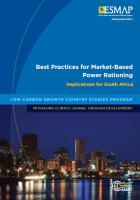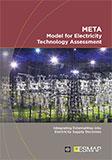Publications

South Africa is the largest economy on the African continent, accounting for about 35 percent of the region’s GDP. South Africa is also the only country in Sub-Saharan Africa that belongs to the ranks of upper middle-income countries. The economy of South Africa is quite energy-intensive. This is the result of both rapid urbanization and electrification, and a mechanized manufacturing sector that requires heavy use of electric power.
After several years of sustained economic growth, supported by reliable and sufficient electricity supply, South Africa’s electricity system came under considerable strain in 2008 when the electricity sector, though generally operationally efficient, ran into major capacity constraints. The power crisis beginning January 2008 was brought on by a combination of supply-side problems, including coal availability, maintenance needs, and unplanned outages that caused power system reserve margins to fall, virtually overnight, from 10% to almost zero.
At the time of the power crisis, the World Bank, assisted by the United Nations Development Program and the Energy Sector Management Assistance Program (ESMAP), was providing support to South Africa’s efforts to develop a low-carbon strategy. Several scenarios were considered where energy efficiency was seen as an essential dimension in reducing South Africa’s carbon footprint. The power crisis further emphasized the urgency for near-term, practical assistance to implement the energy efficiency and demand side management (EE/DSM) measures. An associated program of technical assistance in EE/DSM—a cost-effective, quickly scalable approach to mitigating power shortages and reducing load shedding—was therefore developed to provide timely support to South African counterparts.
This briefing note captures lessons from international experience in dealing with power shortages including key options and issues for implementing a PCP in South Africa. This work was implemented in support of South Africa’s Long Term Mitigation Scenarios (Box 1) and has helped highlight many of the critical challenges facing the country in its efforts to reduce its energy intensity and mobilize cleaner energy sources.
Related links:



